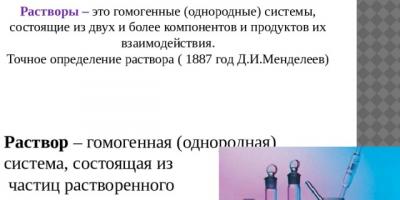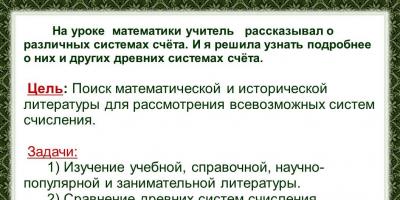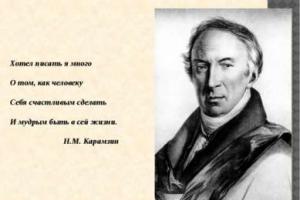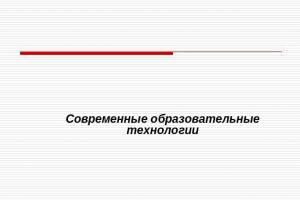Preview:
To use presentation previews, create a Google account and log in to it: https://accounts.google.com
Slide captions:
Developed by: highest category biology teacher Natalya Rafikovna Pavlenko, 2014. Municipal budgetary educational institution “Secondary School No. 4”, Shchekino, Tula Region Water-solvent. The work of water in nature. science lesson in 5th grade
Objectives: Educational: to introduce students to the properties of water as a solvent, to teach how to prepare a solution of salt in water and a suspension of chalk in water, to develop knowledge about the creative and destructive work of water in nature. Developmental: development of mental operations of analysis and synthesis, development of cognitive activity through working with a book and tables, learning to draw conclusions; development of creative abilities, speech development. Educational: instilling patriotism (through the use of a regional component), developing an ecological culture among schoolchildren that does not allow harm to nature by polluting water bodies.
Lesson topic: Water is a solvent. The work of water in nature.
6 groups of class students conducted water research
Geographers (studied the composition of the waters of the World Ocean) Ocean water is a universal, homogeneous ionized solution, which contains 75 chemical elements. These are solid minerals (salts), gases, as well as suspensions of organic and inorganic origin.
Young naturalists (studied distilled water) Distilled water is obtained by distillation in special apparatus - distillers. Even purified water contains small particles of impurities and foreign inclusions.
Chemists (studied the properties of drinking water in Shchekino) In the Tula region, iron is a natural component of groundwater. In addition, the concentration of iron increases when steel and cast iron water pipes corrode.
Ecologists (studied “silver water”) Water poured into silver vessels does not deteriorate for a long time. It contains silver ions, which have a detrimental effect on bacteria in the water.
Biologists (studied the water content in the human body and plants)
Nutritionists (studied Krainska mineral water for the content of salts and carbon dioxide)
Conclusion: There is no clean water in nature.
Laboratory work No. 4 “Preparation of a solution of salt and a suspension of chalk in water.” Goals: learn to prepare a solution and suspension, learn to work with laboratory equipment. Equipment: tray, 2 cups of water, jar No. 1 with salt, jar No. 2 with chalk. Procedure: 1. Move the tray with reagents towards you. 2.Take a glass of water and jar No. 1. Scoop up salt with a spoon. Pour salt into a glass of water and stir with a spoon. What are you observing? What happened to the salt? 3.Take a second glass of water and jar No. 2. Scoop up the chalk with a spoon. Pour it into a glass of water and stir with a spoon. What happened to the chalk? What are you observing? 4. Compare the results of experiments with salt and chalk. How does a solution differ from a suspension? What is a solution? Conclusion:
Conclusion: A solution is a liquid containing foreign substances that are evenly distributed in it.
The creative work of water Water is the habitat of organisms
The creative work of water Water is a source of energy
Creative work of water Transport routes
Creative work of water Formation of fertile silt
The creative work of water During seed germination
Destructive work of water Cave formation
Destructive work of water Floods
Destructive work of water Tsunami
Destructive work of water Formation of ravines
Conclusion: The work of water in nature can be creative and destructive.
Fill in the table (using the text of the textbook paragraph) Creative work of water Destructive work of water
Homework P. 23 Write a short essay on the topic: “The importance of water in nature and human life.”
Thank you for your attention!
List of used literature: Pakulova V.M., Ivanova N.V. “Natural history. Nature. Non-living and living" M.: "Bustard" 2013. Ikher T. P., Shishirina N. E., Tararina L.F. “Ecological monitoring of objects of the aquatic environment” Methodological manual for teachers, students, and schoolchildren., Tula: TOEBTSu, publishing house “Grif and Kº”, 2003. Mazur V.S. “Ecology of the Shchekinsky district of the Tula region”, Shchekino 1997

These are homogeneous (uniform) systems consisting of two or more components and products of their interaction.
Precise determination of solution (1887 D.I. Mendeleev)
Solution– homogeneous (homogeneous) system consisting of
dissolved particles
substance, solvent
and products
their interactions.









Solutions are divided:
- Molecular – aqueous solutions of non-electrolytes
(alcohol solution of iodine, glucose solution).
- Molecular ionic – solutions of weak electrolytes
(nitrous and carbonic acids, ammonia water).
3. Ionic solutions – solutions of electrolytes.

 1g Practically Insoluble S" width="640"
1g Practically Insoluble S" width="640" Solubility –
the property of a substance to dissolve in water or other solution.
Solubility coefficient(S) is the maximum number of g of a substance that can dissolve in 100 g of solvent at a given temperature.
Substances.
Slightly soluble
S =0.01 – 1 g
Highly soluble
Practically Insoluble
S 

Influence of various factors on solubility.
Temperature
Pressure
Solubility
Nature of solutes
Nature of the solvent



Solubility of liquids in liquids depends in a very complex way on their nature.
Three types of liquids can be distinguished, differing in their ability to mutually dissolve.
- Practically immiscible liquids, i.e. incapable of forming mutual solutions(for example, H 2 0 and Hg, H 2 0 and C 6 H 6).
2) Liquids that can be mixed in any ratio, i.e. with unlimited mutual solubility(for example, H 2 0 and C 2 H 5 OH, H 2 0 and CH 3 COOH).
3) Liquids with limited mutual solubility(H 2 0 and C 2 H 5 OS 2 H 5, H 2 0 and C 6 H 5 NH 2).





Significant Impact pressure affects only the solubility of gases.
Moreover, if no chemical interaction occurs between the gas and the solvent, then according to
Henry's law: the solubility of a gas at a constant temperature is directly proportional to its pressure above the solution


Methods of expressing the composition of solutions 1. shares 2. Concentrations

Mass fraction of solute in solution– the ratio of the mass of the solute to the mass of the solution. (fractions of a unit/percent)



Solution concentration –

Molarity- the number of moles of dissolved substance in 1 liter of solution.
ʋ - amount of substance (mol);
V – solution volume (l);


Equivalent concentration (normality) – the number of equivalents of a dissolved substance in 1 liter of solution.
ʋ eq. - number of equivalents;
V – volume of solution, l.

Expression of concentrations of solutions.
Molal concentration (molality)– number of moles of solute per 1000 g of solvent.
“Mass fraction of a substance” - Density. Denoted by Vm. Мср = ?1 M1 + ?2 M2 + ?3 M3 + ... volume fraction? = V1 / Vtot. Denoted w. Calculated in shares or percentages. Molar concentration: c (in-va) = n (in-va) / Vsystem in mol/l. Relative density is calculated in relative units.). The density of any substance is calculated by the formula? = m/V, usually measured in g/ml or g/l.
“Ferromagnetic fluid” - Ferromagnetic fluid is a “smart” fluid. Application: converting the energy of vibrational motion into electrical energy. Video. MAOU Siberian Lyceum. “I am inspired by life itself, nature itself. Application: electronic devices. Ferromagnetic fluid can reduce friction. Application: magnetic separation of ores.
“Magnetic properties of matter” - Ferrites have high magnetization values and Curie temperatures. where is the coefficient of proportionality, which characterizes the magnetic properties of a substance and is called the magnetic susceptibility of the medium. Some materials retain their magnetic properties even in the absence of an external magnetic field. Magnetic moment of an electron and an atom Atom in an external magnetic field.
“Structure of the substance of the molecule” - CH3OH + HBr. CH3?CH2?NO2. Mutual influence of atoms in molecules using the example of aniline. + 2Na. CH3OH + NaOH. S2n6. CH4. HC?C?CH2?CH3. Structural. Isomers -. 2nd position. Theory of chemical structure A.M. Butlerov. Increase in basic properties.
"Dispersed systems" - Aerosols. According to the state of aggregation of the dispersion medium and the dispersed phase. Dispersion medium: Gelatinous sediments formed during the coagulation of sols. Press any key. Gels. Natural water always contains dissolved substances. Classification of disperse systems. Solutions. Dispersed phase: Suspensions.
“Pure substances and mixtures” - 1. A mixture is: ? Conclusions: What types of mixtures are there? Filtration. Calcium phosphate. Pure substances and mixtures. ZnO, ZnCl2, H2O. SO3, MgO, CuO. A pure substance has constant physical properties (tboil, tmelt, ?, etc.). Distillation (distillation). Methods for separating mixtures. In what ways can mixtures be separated?
There are a total of 14 presentations in the topic
Solutions A solution is a homogeneous, multicomponentvariable composition system containing
products of interaction of components –
solvates (for aqueous solutions - hydrates).
Homogeneous means homogeneous, single-phase.
A visual indication of the homogeneity of liquids
solutions is their transparency. Solutions consist of at least two
components: solvent and soluble
substances.
The solvent is the component
the amount of which in solution is usually
predominates, or that component, aggregate
whose state does not change when
formation of a solution.
Water
Liquid The solute is
a component taken in deficiency, or
a component whose state of aggregation
changes when a solution is formed.
Solid salts
Liquid The components of the solutions retain their
unique properties and do not enter into
chemical reactions with each other
the formation of new compounds,
.
BUT
solvent and solute, forming
solutions interact. Process
interaction between solvent and solute
of a substance is called solvation (if
The solvent is water - hydration).
As a result of chemical interaction
solute with solvent
more or less stable are formed
complexes characteristic only of solutions,
which are called solvates (or hydrates). The core of the solvate is formed by a molecule, atom or
solute ion, shell –
solvent molecules. Several solutions of the same substance will
contain solvates with a variable number of molecules
solvent in the shell. It depends on the quantity
solute and solvent: if dissolved
there is little substance and a lot of solvent, then the solvate has
saturated solvation shell; if dissolved
there is a lot of substance - a rarefied shell.
Variability in the composition of solutions of the same
substances are usually shown by differences in their concentration
Non-concentrated
solution
Concentrated
solution Solvates (hydrates) are formed due to
donor-acceptor, ion-dipole
interactions or due to hydrogen
connections.
Ions are especially prone to hydration (as
charged particles).
Many of the solvates (hydrates) are
fragile and easily decomposed. However, in
In some cases, strong
compounds that can be isolated from
solution only in the form of crystals,
containing water molecules, i.e. as
crystal hydrates.
Dissolution as a physical and chemical process
The dissolution process (inherently a physical processcrushing of the substance) due to the formation of solvates
(hydrates) may be accompanied by the following phenomena
(characteristic of chemical processes):
absorption
change
or generation of heat;
volume (as a result of the formation
hydrogen bonds); highlighting
gas or sedimentation (as a result of
hydrolysis occurring);
change in the color of the solution relative to the color
dissolved substance (as a result of the formation
aqua complexes) etc.
freshly prepared solution
(emerald color)
solution after some time
(gray-blue-green color)
These phenomena allow us to attribute the dissolution process to
complex, physical and chemical process.
Classifications of solutions
1. According to the state of aggregation:- liquid;
- hard (many metal alloys,
glass). 2. By the amount of dissolved substance:
- unsaturated solutions: dissolved in them
less substance than can be dissolved
this solvent at normal
conditions (25◦C); these include the majority
medical and household solutions. . - saturated solutions are solutions in which
of which there is so much dissolved substance,
how much can a given one dissolve?
solvent under normal conditions.
A sign of solution saturation
is their inability to dissolve
additional quantity introduced into them
soluble substance.
These solutions include:
waters of the seas and oceans,
human fluid
body. - supersaturated solutions are solutions in which
of which there is more solute than
can dissolve the solvent at
normal conditions. Examples:
carbonated drinks, sugar syrup. Supersaturated solutions are formed
only in extreme conditions: when
high temperature (sugar syrup) or
high blood pressure (carbonated drinks). Supersaturated solutions are unstable and
upon return to normal conditions
“getting old”, i.e. delaminate. Excess
the solute crystallizes or
released as gas bubbles
(returns to the original aggregate
state). 3. By type of solvates formed:
-ionic solutions - solute
dissolves to ions.
-Such solutions are formed under the condition
polarity of the solute and
solvent and excess of the latter. Ionic solutions are quite resistant to
delamination, and are also capable of conducting
electric current (are conductors
electric current of the second kind) - molecular solutions – soluble
the substance breaks down only into molecules.
Such solutions are formed under the following conditions:
- polarity mismatch
solute and solvent
or
- polarity of the solute and
solvent, but insufficient
the last one.
Molecular solutions are less stable
and are not capable of conducting electric current Scheme of the structure of the molecular solvate on
Example of soluble protein:
Factors influencing the dissolution process
1. Chemical nature of the substance.Direct influence on the process
the dissolution of substances is influenced by their polarity
molecules, which is described by the similarity rule:
like dissolves into like.
Therefore, substances with polar molecules
dissolves well in polar
solvents and poorly in non-polar and
vice versa. 2. Temperature.
For most liquids and solids
characterized by an increase in solubility with
temperature rise.
Solubility of gases in liquids with
decreases with increasing temperature, and with
decrease - increases. 3. Pressure. With increasing pressure
solubility of gases in liquids
increases, and with decrease –
decreases.
On the solubility of liquid and solid
substances, changes in pressure do not affect.
Methods of expressing the concentration of solutions
There are various waysexpressing the composition of the solution. Most often
are used such as mass fraction
solute, molar and
mass concentration.
Mass fraction of solute
This is a dimensionless quantity equal to the ratiomass of solute to total mass
solution:
w% =
msubstances
m solution
100%
For example, a 3% alcohol solution of iodine
contains 3g iodine per 100g solution or 3g iodine per 97g
alcohol
Molar concentration
Shows how many moles of dissolvedsubstances contained in 1 liter of solution:
SM =
nsubstances
VM
solution
=
msubstances
Vsubstances ´
solution
Substance - molar mass of dissolved
substances (g/mol).
The unit of measurement for this concentration is
is mol/l (M).
For example, a 1M solution of H2SO4 is a solution
containing 1 mole (or 98 g) of sulfur in 1 liter
Mass concentration
Indicates the mass of a substance locatedin one liter of solution:
C=
substances
V solution
Unit of measurement – g/l.
This method is often used to evaluate the composition
natural and mineral waters. Theory
electrolytic
dissociation
ED is the process of electrolyte breakdown into ions
(charged particles) under the influence of polar
solvent (water) to form solutions,
capable of conducting electric current.
Electrolytes are substances that can
disintegrate into ions.
Electrolytic dissociation
Electrolytic dissociation is causedinteraction of polar solvent molecules with
particles of the solute. This
interaction leads to polarization of bonds, in
resulting in the formation of ions due to
“weakening” and breaking of bonds in molecules
soluble substance. Transition of ions into solution
accompanied by their hydration:
Electrolytic dissociation
Quantitatively, ED is characterized by the degreedissociation (α); she expresses an attitude
dissociated molecules into ions
the total number of molecules dissolved in a solution
(changes from 0 to 1.0 or from 0 to 100%):
n
a = ´100%
N
n – molecules dissociated into ions,
N is the total number of molecules dissolved in
solution.
Electrolytic dissociation
The nature of the ions formed during dissociationelectrolytes – different.
In salt molecules, upon dissociation, they form
metal cations and acid residue anions:
Na2SO4 ↔ 2Na+ + SO42 Acids dissociate to form H+ ions:
HNO3 ↔ H+ + NO3 Bases dissociate to form OH- ions:
KOH ↔ K+ + OH-
Electrolytic dissociation
According to the degree of dissociation, all substances can bedivided into 4 groups:
1. Strong electrolytes (α>30%):
alkalis
(bases highly soluble in water
group IA metals – NaOH, KOH);
monobasic
acids and sulfuric acid (HCl, HBr, HI,
HNO3, HClO4, H2SO4 (dil.));
All
water-soluble salts.
Electrolytic dissociation
2. Average electrolytes (3%<α≤30%):acids
– H3PO4, H2SO3, HNO2;
dibasic,
water-soluble bases -
Mg(OH)2;
soluble
transition metal salts in water,
entering the process of hydrolysis with a solvent –
CdCl2, Zn(NO3)2;
salt
organic acids – CH3COONa.
Electrolytic dissociation
3. Weak electrolytes (0.3%<α≤3%):inferior
organic acids (CH3COOH,
C2H5COOH);
some
water soluble inorganic
acids (H2CO3, H2S, HCN, H3BO3);
almost
all salts and bases that are slightly soluble in water
(Ca3(PO4)2, Cu(OH)2, Al(OH)3);
hydroxide
water.
ammonium – NH4OH;
Electrolytic dissociation
4. Non-electrolytes (α≤0.3%):insoluble
majority
in water there are salts, acids and bases;
organic compounds (as
soluble and insoluble in water)
Electrolytic dissociation
The same substance can be both strong,and a weak electrolyte.
For example, lithium chloride and sodium iodide, which have
ionic crystal lattice:
when dissolved in water they behave like typical
strong electrolytes,
when dissolved in acetone or acetic acid
are weak electrolytes with a degree
dissociation is less than unity;
in a “dry” form they act as non-electrolytes.
Ionic product of water
Water, although a weak electrolyte, partially dissociates:H2O + H2O ↔ H3O+ + OH− (correct, scientific notation)
or
H2O ↔ H+ + OH− (short notation)
In completely pure water, the concentration of ions at ambient conditions is always constant
and is equal to:
IP = × = 10-14 mol/l
Since in pure water = , then = = 10-7 mol/l
So, the ionic product of water (IP) is the product of concentrations
hydrogen ions H+ and hydroxyl ions OH− in water.
Ionic product of water
When any substance is dissolved in watersubstances equality of ion concentrations
= = 10-7 mol/l
may be violated.
Therefore, the ionic product of water
allows you to determine concentrations and
any solution (that is, determine
acidity or alkalinity of the environment).
Ionic product of water
For ease of presentation of resultsacidity/alkalinity of the environment is used
not absolute concentration values, but
their logarithms – hydrogen (pH) and
hydroxyl (pOH) indicators:
+
pH = - log[H]
-
pOH = - log
Ionic product of water
In a neutral environment = = 10-7 mol/l and:pH = - log(10-7) = 7
When adding acid (H+ ions) to water,
the concentration of OH− ions will fall. Therefore, when
pH< lg(< 10-7) < 7
the environment will be acidic;
When adding alkali (OH− ions) to water, the concentration
will be more than 10−7 mol/l:
-7
pH > log(> 10) > 7
, and the environment will be alkaline.
Hydrogen indicator. Indicators
Acid-base tests are used to determine pH.indicators are substances that change color when
depending on the concentration of H + and OH- ions.
One of the most famous indicators is
universal indicator, colored when
excess H+ (i.e. in an acidic environment) turns red, when
excess OH- (i.e. in an alkaline environment) - blue and
having a yellow-green color in a neutral environment:
Hydrolysis of salts
The word "hydrolysis" literally means "decomposition"water."
Hydrolysis is the process of interaction of ions
solute with water molecules with
formation of weak electrolytes.
Since weak electrolytes are released as
gases, precipitate or exist in solution in
undissociated form, then hydrolysis can be
consider a chemical reaction of a solute
with water.
1. To make it easier to write hydrolysis equations
all substances are divided into 2 groups:
electrolytes (strong electrolytes);
non-electrolytes (medium and weak electrolytes and
non-electrolytes).
2. Acids and
bases, since the products of their hydrolysis are not
differ from the original composition of solutions:
Na-OH + H-OH = Na-OH + H-OH
H-NO3 + H-OH = H-NO3 + H-OH
Hydrolysis of salts. Writing rules
3. To determine the completeness of hydrolysis and pHsolution, write 3 equations:
1) molecular - all substances are presented in
in the form of molecules;
2) ionic – all substances capable of dissociation
written in ionic form; in the same equation
free identical ions are usually excluded from
left and right sides of the equation;
3) final (or resulting) – contains
the result of the “reductions” of the previous equation.
Hydrolysis of salts
1. Hydrolysis of salt formed by strongbase and strong acid:
Na+Cl- + H+OH- ↔ Na+OH- + H+ClNa+ + Cl- + H+OH- ↔ Na+ + OH- + H+ + ClH+OH- ↔ OH- + H+
Hydrolysis does not occur, the solution medium is neutral (since
the concentration of OH- and H+ ions is the same).
Hydrolysis of salts
2. Hydrolysis of a salt formed by a strong base andweak acid:
C17H35COO-Na+ + H+OH- ↔ Na+OH- + C17H35COO-H+
C17H35COO- + Na+ + H+OH- ↔ Na+ + OH- + C17H35COO-H+
C17H35COO- + H+OH- ↔ OH- + C17H35COO-H+
Partial hydrolysis, by anion, alkaline solution medium
OH-).
Hydrolysis of salts
3. Hydrolysis of the salt formed by a weak base andstrong acid:
Sn+2Cl2- + 2H+OH- ↔ Sn+2(OH-)2 ↓+ 2H+ClSn+2 + 2Cl- + 2H+OH- ↔ Sn+2(OH-)2 + 2H+ + 2ClSn+2 + 2H +OH- ↔ Sn+2(OH-)2 + 2H+
Partial hydrolysis, according to the cation, the solution medium is acidic
(since an excess of ions remains in the solution in free form
H+).
Hydrolysis of salts
4. Hydrolysis of a salt formed by a weak base and a weakacid:
Let's try to obtain aluminum acetate salt in an exchange reaction:
3CH3COOH + AlCl3 = (CH3COO)3Al + 3HCl
However, in the table of solubility of substances in water such
there is no substance. Why? Because it enters the process
hydrolysis with water contained in the original solutions
CH3COOH and AlCl3.
(CH3COO)-3Al+3+ 3H+OH- = Al+3(OH-)3 ↓+ 3CH3COO-H+
3CH3COO-+ Al+3 + 3H+OH- = Al+3(OH-)3 ↓+ 3CH3COO-H+
Hydrolysis is complete, irreversible, the solution environment is determined
electrolytic strength of hydrolysis products.
G. P. Yatsenko
Slide 2
Solutions are homogeneous (homogeneous) systems consisting of two or more components and products of their interaction. Exact definition of the solution (1887 D.I. Mendeleev):
A solution is a homogeneous (homogeneous) system consisting of particles of a dissolved substance, a solvent and the products of their interaction.
Slide 3
Types of solutions
Solutions are divided:
- Molecular - aqueous solutions of non-electrolytes (alcohol solution of iodine, glucose solution).
- Molecular ionic – solutions of weak electrolytes (nitrous and carbonic acids, ammonia water).
- Ionic solutions are solutions of electrolytes.
Slide 4
Dissolution is a physical and chemical process in which, along with the formation of a conventional mechanical mixture of substances, there is a process of interaction of particles of a dissolved substance with a solvent.
Slide 5
Solubility
Solubility is the property of a substance to dissolve in water or other solution.
Solubility coefficient (S) is the maximum number of g of a substance that can dissolve in 100 g of solvent at a given temperature.
Substances:
- Highly soluble S > 1g
- Slightly soluble S = 0.01 – 1 g
- Insoluble S< 0,01 г
Slide 6
Influence of various factors on solubility
- Temperature
- Pressure
- Nature of solutes
- Nature of the solvent
Slide 7
Solution concentration
The concentration of a solution is the content of a substance in a certain mass or volume of a solution.
Slide 8
Expression of concentrations of solutions.
The mass fraction of a solute in a solution is the ratio of the mass of the solute to the mass of the solution. (fractions of a unit/percent)
Slide 9
Molarity is the number of moles of dissolved substance in 1 liter of solution.
- ʋ - amount of substance (mol);
- V – solution volume (l);
Slide 10
Expression of solution concentrations
Equivalent concentration (normality) – the number of equivalents of a dissolved substance in 1 liter of solution.
- v eq. - number of equivalents;
- V – volume of solution, l.
Slide 11
Molal concentration (molality) is the number of moles of solute per 1000 g of solvent.
Slide 12
Natural solutions
- Mineral water.
- Animal blood.
- Sea water.
Slide 13
Practical application of solutions
- Food.
- Medications.
- Mineral table waters.
- Raw materials of industry.
- Biological significance of solutions.
Slide 14
Materials used for decoration
Slide 15
Information for teachers
The resource is intended for 11th grade students. It serves as an illustration for mastering the topic “Solutions. Quantitative characteristics of solutions.”
The presentation discusses the basic concepts of the topic, formulas for quantitative expressions of solution concentrations.
The material can be used in fragments in chemistry lessons in grades 8–9.
The resource is designed for the use of O.S.Gabrielyan’s educational complex.
View all slides








